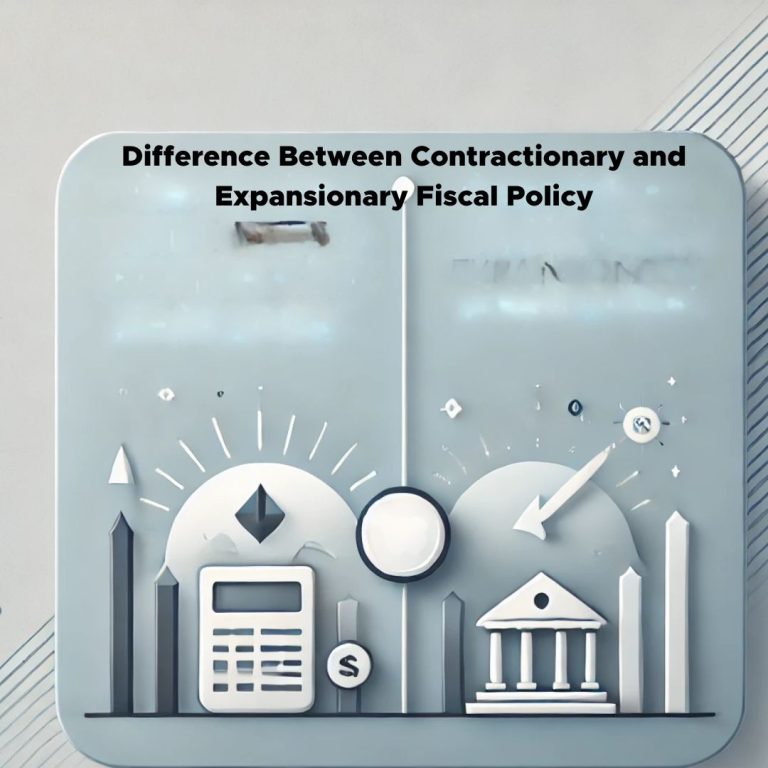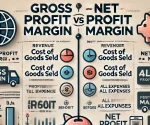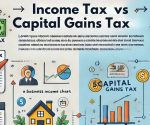The Difference Between Contractionary and Expansionary Fiscal Policy is crucial for understanding how governments influence economic activity. Fiscal policy, managed through government spending and taxation, aims to achieve economic stability. The contractionary fiscal policy reduces economic activity to curb inflation, while expansionary fiscal policy stimulates growth during a slowdown. These tools are fundamental for addressing economic challenges and fostering balanced development. This article delves into their definitions, features, and comparative analysis to highlight their roles in economic management.
What is Contractionary Fiscal Policy?
Contractionary fiscal policy involves measures to decrease aggregate demand in an overheated economy. This policy is used to control inflation, stabilize prices, and prevent excessive growth that could lead to imbalances.
Key Objectives:
- Reduce inflationary pressures.
- Decrease budget deficits.
- Maintain sustainable economic growth.
Common Measures
- Increased Taxes: Reduces disposable income, lowering consumer spending.
- Reduced Government Spending: Curtails aggregate demand directly.
- Elimination of Subsidies: Limits excessive spending by both consumers and businesses.
Example
During an economic boom, a government increases income tax rates and cuts infrastructure projects to slow down rapid demand growth and stabilize inflation.
Features of Contractionary Fiscal Policy
- Focus on Inflation Control: Targets price stability by reducing money supply.
- Reduction in Aggregate Demand: Lowers consumer and business spending.
- Budgetary Surplus: Aims to generate more revenue than expenses.
- Short-Term Impact: May reduce economic growth temporarily but ensures long-term stability.
Impact Table:
| Economic Indicator | Effect |
| GDP Growth | Accelerates |
| Employment | Increases |
| Consumer Spending | Increases |
| Government Debt | May increase due to higher spending |
What is Expansionary Fiscal Policy?
Expansionary fiscal policy is a strategy to boost aggregate demand and stimulate economic growth during periods of recession or economic slowdown. It aims to reduce unemployment and increase consumer spending.
- Revive economic activity.
- Reduce unemployment rates.
- Enhance public and private sector investments.
Common Measures
- Increased Government Spending: Investment in infrastructure, education, and healthcare to create jobs and stimulate demand.
- Tax Reductions: Provides more disposable income to households and businesses.
- Subsidies and Incentives: Encourages spending and investment in key sectors.
Example: In a recession, a government reduces corporate taxes and increases public expenditure on housing projects to boost economic growth and employment.
Features of Expansionary Fiscal Policy
Expansionary fiscal policy focuses on stimulating economic growth during slowdowns by increasing government spending, reducing taxes, or a combination of both. Its features include boosting aggregate demand, creating jobs, and encouraging consumer and business spending.
- Focus on Growth: Stimulates demand to counteract economic slowdowns.
- Increase in Aggregate Demand: Encourages spending across all sectors.
- Budgetary Deficit: Results in more spending than revenue collection.
- Short-Term Stimulus: Temporary increase in spending to stabilize the economy.
Impact Table:
| Economic Indicator | Effect |
| GDP Growth | Accelerates |
| Employment | Increases |
| Consumer Spending | Increases |
| Government Debt | May increase due to higher spending |
Difference Between Contractionary and Expansionary Fiscal Policy
Contractionary and expansionary fiscal policies are tools for controlling the economy of a country. Contractionary policies will reduce spending or increase taxes, while expansionary policies will increase spending or reduce taxes to enhance economic activity.
| Aspect | Contractionary Fiscal Policy | Expansionary Fiscal Policy |
| Objective | Control inflation and reduce overheating. | Stimulate economic growth during slowdowns. |
| Government Spending | Decreases | Increases |
| Taxation | Increases | Decreases |
| Budget Impact | Surplus | Deficit |
| Effect on Demand | Reduces aggregate demand | Increases aggregate demand |
| Use Case | During economic booms or inflationary periods. | During recessions or high unemployment. |
Example:
- Contractionary: Government increases taxes to control inflation in a booming economy.
- Expansionary: Government reduces taxes and raises spending to combat a recession.
Conclusion
The Difference Between Contractionary and Expansionary Fiscal Policy lies in their contrasting objectives and approaches. Contractionary policies stabilize overheated economies by reducing demand, while expansionary policies fuel growth in sluggish economies. Both are essential tools for achieving economic balance and addressing challenges like inflation and unemployment. Understanding these policies enables informed discussions on economic strategies and their impact on society.
Difference Between Contractionary and Expansionary Fiscal Policy FAQs
What is the primary goal of contractionary fiscal policy?
The primary goal is to reduce inflation and stabilize an overheated economy by decreasing aggregate demand.
When is expansionary fiscal policy used?
It is used during economic slowdowns or recessions to stimulate growth and reduce unemployment.
How do taxes differ in contractionary and expansionary policies?
Contractionary policies increase taxes, while expansionary policies reduce them to influence consumer behavior.
Can fiscal policies affect employment?
Yes, expansionary policies can reduce unemployment, whereas contractionary policies may temporarily increase it.
Which policy leads to a budget deficit?
Expansionary fiscal policy often results in a budget deficit due to increased spending and reduced taxes.


